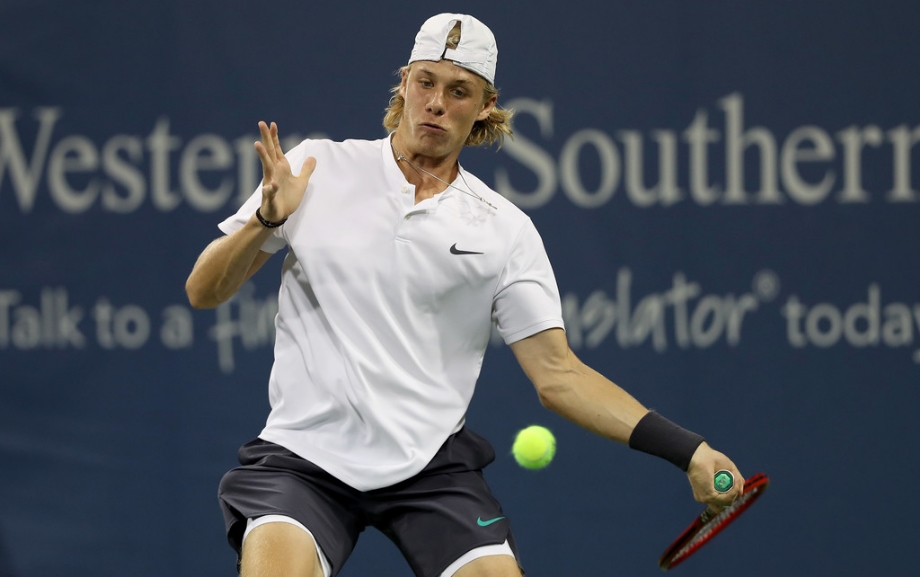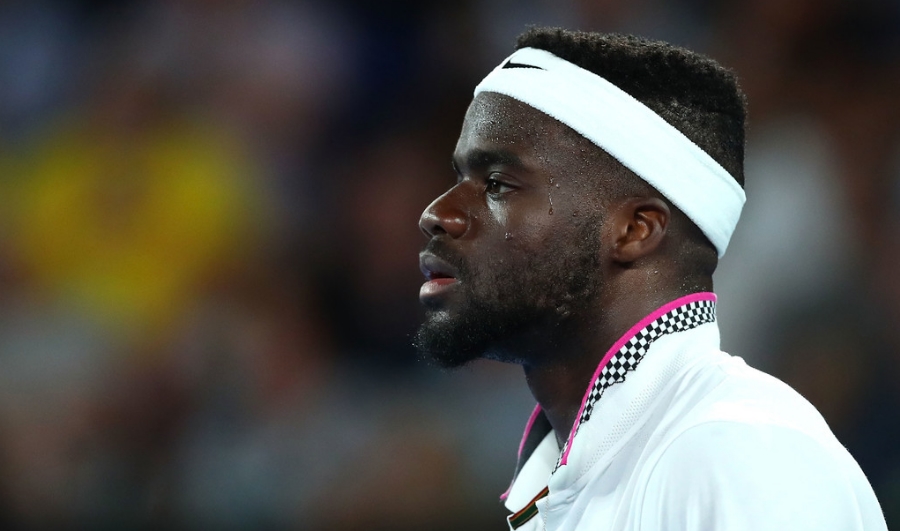Don’t shoot the messenger! I am only quoting in the title what Denis Shapovalov said right after defeating Frances Tiafoe 6-7 6-4 6-2 on Thursday night at the Miami Open and earning the right to play Roger Federer in the semifinals on Friday. He also said: “I’ve been looking forward to this matchup, I think, my whole life.”
If you are a Shapovalov fan, you are probably feeling somewhere between happy and ecstatic, with good reason! Your player just won his second impressive match in a row, showing improvements not only in his game but in his mental fortitude. You can read my post-match report – click here – on his victory over Stefanos Tsitsipas on Tuesday, in what I believe to be the most thrilling match of the tournament so far on the men’s side. It was a shot-making festival of sorts, with each player responding to the challenges raised by the other, culminating in an electrifying final set that went to a tiebreaker.

Photo: Matthew Stockman – Getty Images North America
Thursday’s match against Tiafoe was a slightly different type of conquest for Shapovalov in texture and content. As far as fans of Denis are concerned, the satisfying (or nerve-wrecking) part of this win is that the Canadian came out on top despite not performing nearly as well as he did on Tuesday. In fact, he blew a number of chances that turned out to be costly. Yet, he knew how to quickly stack those disappointing moments to the back of his head (probably to be revisited at a later point) and keep a clear vision on the target in front. When time arrived to ultimately grab the decisive lead, he did not flinch.
The first set was a straight-forward and entertaining affair, in that players dominated their service games not because they hit a slew of aces, but rather because they served efficiently by keeping high percentage on their their first serves and picking the right spots to hit in the service box. Simply put, if you wanted to argue that a server can cruise through his service games without striking ace after ace, the first set needed to be your exhibit A. Shapovalov served at 61% first serves with only two aces, and Tiafoe at 61% with three. Neither even came close to facing a break point until the last two games prior to the tiebreaker (one in each). Both players enjoyed a high success rate at the net until the tiebreaker, with Denis winning five out of six points in which he decided to approach the net, Frances four out of five**.
**Clarification: I count as “approach” any point at which the player decides to come to the net behind a strong shot. I include it in my count even if the opponent misses the next shot and he wins the point without hitting a volley. It’s the pressure applied to the opponent by coming forward that counts.
A key moment came when Tiafoe had a break-point chance at 5-5 and Shapovalov saved it with an ace (one of two in the set for him). In the very next game, he was the one with the break-point opportunity which also meant a set point at 6-5. Denis hit a routine forehand wide, a disappointing unforced error at an inopportune time. He was not even going for a winner. It was a loopy, topspin forehand aimed to Tiafoe’s backhand. Considering his style, one can wonder if Shapovalov would have been more likely to hit the ball in the court, had he unleashed on that forehand for a winner instead of going conservative.
Another disappointing moment came shortly after when Tiafoe led 3-2 in the tiebreaker and Shapovalov had another routine forehand from almost the exact same position as the one he missed on set point. This time, he struck it hard to the other corner for a winner and missed it badly. So, back to the question above, but in reverse: would he have avoided the error had he been more reserved and not gone for a flashy winner? You see how comfortable things can be in the peanut gallery?
The only valid answer to either of the questions above: it’s easy to theorize in retrospect.
That being said, there was nothing ambiguous about Denis’s third disappointing moment of the set. At 4-5 in the tiebreaker, Tiafoe hit a dismal drop shot that bounced high. Shapovalov got there without too much trouble and line up for a forehand. The deuce corner on Tiafoe’s side was wide open and Denis went there, but sailed it deep. Suddenly, he was down two set points. On the second set point, Tiafoe hit a spectacular backhand return smack to the baseline, one that the Canadian could not send back over the net.
Speaking of Tiafoe, I am deeply in awe of how much he has improved his overall game. Angles, he can hit. Drop shots, he can place. Volleys, he can put away. Returns, well, just see the set point. Add to the mix his ground strokes that have, over the last couple of years, upgraded in terms of velocity and accuracy, and you have a young player that has as much potential as the rest of the exciting up-and-comers making noise so far this year.

Photo: Cameron Spencer – Getty Images AsiaPac
When Frances went up 1-0 in the second and led 0-15 on Denis’s serve, thanks to a stellar forehand passing shot he hit on the run (and may I add, one hit with a semi-continental grip, thus somewhat scooped and flat), it looked as if the American was about to break free and sprint to the finish line.
Down 0-1, 0-15 on his serve, Shapovalov persevered. He hit four first serves in a row and quickly halted the down-slide by holding. This game also included a charming moment when he hit one of several amazing drop volleys showcased throughout the match by both. Tiafoe walked up to the net and gave him a congratulatory hand-slap. Then, Shapovalov broke his opponent’s serve for the first break of the match for either player, in a game that featured two high-octane returns by the Canadian on Tiafoe’s first serves.
Shapovalov, whose chances of winning were looking grim around 8 minutes ago, now caught fire. He hit 80% of his first serves in and won all five points on approaches during a four-game sequence that placed him at a 5-1 lead. He has two set-point chances in that game. Tiafoe saved the first one with a fine approach and a put-away volley. On the second one, Shapovalov had an easy forehand to hit inside the baseline, in the middle of the court, one that he should generally put away. He missed it in the net and Tiafoe held serve.
Tiafoe slowly closed the gap back to 5-4, but he fell short of stopping Shapovalov from winning the second set because the Canadian did not allow the disappointment of the blown forehand on set point back at 5-1 linger in his mind. It is not a secret that Shapovalov has squandered similar leads more than once in the past couple of years. I must confess that I thought he might get tight at that point, especially when I saw him jump around at the baseline trying to remain concentrated in the moment while Tiafoe was getting medical treatment during the extended 5-4 changeover.
Once again, Shapovalov did not falter. He started the game with two effective 1-2 punch combinations to go up 30-0 and served an ace at 40-0 (one of his two for the set) to send the match to a final set. Just like against Tsitsipas, Shapovalov figured out a way to rise to the occasion after losing the first set, and did not have any let downs for the remainder of the match.
Tiafoe, for his part, could never recapture his form from earlier in the match. He played his worst service game at 1-1 in the final set, committing three unforced errors from the baseline to fall behind a break. Another backhand unforced error in the 2-4 game put him down by two breaks. Shapovalov closed the match out on the next game.
For the record, Shapovalov finished the match hitting 69% of first serves in, while chipping in seven aces and one double fault. At least three of his seven aces that I can remember were on clutch points (two on break points, one to save a set point). Tiafoe did not fare as well in this department, serving at 62%, with five aces and six double faults.
Let me finish with a detail that should make fans of both Shapovalov and Tiafoe happy. Denis decided to approach 32 times and won 22 of those points. Frances approached 20 times, winning 14. These are fairly solid ratios, but I was looking for something else. In the past, I have seen Shapovalov and Tiafoe hit big shots from the baseline, put their opponents on the run, yet stay back at the baseline, thus allowing the opponent to loop the ball back and recover to the middle of the court.
So, this time I paid particular attention to their decision-making when they had their opponent scrambling. I looked for points where one had the other on the run, and instead of moving forward and putting more pressure on the opponent, he stayed back. I also looked for balls that came short and allowed either of them to step inside the baseline for a set acceleration shot. If the player in question did not hit that ball with the intention of coming to the net behind, I counted that against them. For one example of what I mean, consider the 5-2, 0-30 point in the second set. Tiafoe’s return falls short in the middle of the court. Shapovalov moves inside the baseline and has a chance to strike a forehand to one of the corners and move up to the net, which is something he has successfully done numerous times in this match. For some odd reason, he stays back on that occasion and engages in a rally. He misses a backhand several shots later and Tiafoe wins the point.
By my count, there was a total of six points (four by Denis, two by Frances) where they passed on an opportunity to approach. That is a low number considering that neither player’s plan A revolves around volleying. In other words, these guys are not afraid to approach, which also means that their net skills are bound to rapidly improve. Transition game is not something you master by studying or watching. Practice drills help, but ultimately, players committed to developing their transition game understand that in order to master that skill, they must literally do it under the pressure of the scoreboard. This is why fans of these two players should be excited. This match is one example of how both Shapovalov and Tiafoe have their eyes set on becoming the best all-around players that they can be.
As for Shapovalov’s “dream-come-true” match, Federer awaits him on Friday evening, “Not Before 7:00 PM.”
Make your plans accordingly!
